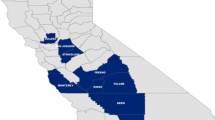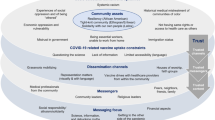Abstract
To describe the reach, implementation, and sustainability of COVID-19 vaccination programs delivered by social service community organizations. Five academic institutions in the Chicagoland CEAL (Community Engagement Alliance) program partnered with 17 community organizations from September 2021—April 2022. Interviews, community organizations program implementation tracking documents, and health department vaccination data were used to conduct the evaluation. A total of 269 events were held and 5,432 COVID-19 vaccines delivered from May 2021–April 2022. Strategies that worked best included offering vaccinations in community settings with flexible and reliable hours; pairing vaccinations with ongoing social services; giving community organizations flexibility to adjust programs; offering incentives; and vaccinating staff first. These strategies and partnership structures supported vaccine uptake, community organization alignment with their missions and communities’ needs, and trust. Community organizations delivering social services are local community experts and trusted messengers. Pairing social service delivery with COVID-19 vaccination built individual and community agency. Giving COs creative control over program implementation enhanced trust and vaccine delivery. When given appropriate resources and control, community organizations can quickly deliver urgently needed health services in a public health crisis.

Similar content being viewed by others
References
Hooper, M. W., Nápoles, A. M., & Pérez-Stable, E. J. (2020). COVID-19 and racial/ethnic disparities. JAMA, 323(24), 2466–2467. https://doi.org/10.1001/jama.2020.8598
Magesh, S., John, D., Li, W. T., Li, Y., Mattingly-App, A., Jain, S., Chang, E. Y., & Ongkeko, W. M. (2021). Disparities in COVID-19 outcomes by race, ethnicity, and socioeconomic status: a systematic-review and meta-analysis. JAMA Network Open. https://doi.org/10.1001/jamanetworkopen.2021.34147
Tsui, J., Hirsch, J. A., Bayer, F. J., Quinn, J. W., Cahill, J., Siscovick, D., & Lovasi, G. S. (2020). Patterns in geographic access to health care facilities across neighborhoods in the United States based on data from the National Establishment Time-Series between 2000 and 2014. JAMA Network Open. https://doi.org/10.1001/jamanetworkopen.2020.5105
Triana, A. J., Gusdorf, R. E., Shah, K. P., & Horst, S. N. (2020). Technology literacy as a barrier to telehealth during COVID-19. Telemedicine and e-Health, 26(9), 1118–1119. https://doi.org/10.1089/tmj.2020.0155
Nguyen, L. H., Joshi, A. D., Drew, D. A., Merino, J., Ma, W., Lo, C. H., Kwon, S., Wang, K., Graham, M. S., Polidori, L., Menni, C., Sudre, C. H., Anyane-Yeboa, A., Astley, C. M., Warner, E. T., Hu, C. Y., Selvachandran, S., Davies, R., Nash, D., COPE Consortium. (2022). Self-reported COVID-19 vaccine hesitancy and uptake among participants from different racial and ethnic groups in the United States and United Kingdom. Nature Communications, 13(1), 636. https://doi.org/10.1038/s41467-022-28200-3
McFadden, S. M., Demeke, J., Dada, D., Wilton, L., Wang, M., Vlahov, D., & Nelson, L. E. (2022). Confidence and hesitancy during the early roll-out of COVID-19 vaccines among Black, Hispanic, and undocumented immigrant communities: A review. Journal of Urban Health, 99(1), 3–14. https://doi.org/10.1007/s11524-021-00588-1
Bajaj, S. S., & Stanford, F. C. (2021). Beyond Tuskegee: vaccine distrust and everyday racism. The New England Journal of Medicine. https://doi.org/10.1056/NEJMpv2035827
Bailey, Z. D., Krieger, N., Agénor, M., Graves, J., Linos, N., & Bassett, M. T. (2017). Structural racism and health inequities in the USA: evidence and interventions. Lancet, 389(10077), 1453–1463. https://doi.org/10.1016/S0140-6736(17)30569-X
Marsh, E. E., Kappelman, M. D., Kost, R. G., Mudd-Martin, G., Shannon, J., Stark, L. A., & Carrasquillo, O. (2021). Community engagement during COVID: a field report from seven CTSAs. Journal of Clinical and Translational Science. https://doi.org/10.1017/cts.2021.785
Dada, D., Djiometio, J. N., McFadden, S. M., Demeke, J., Vlahov, D., Wilton, L., Wang, M., & Nelson, L. E. (2022). Strategies that promote equity in COVID-19 vaccine uptake for Black communities: a review. Journal of Urban Health, 99(1), 15–27. https://doi.org/10.1007/s11524-021-00594-3
Gilmore, B., Ndejjo, R., Tchetchia, A., de Claro, V., Mago, E., Diallo, A. A., Lopes, C., & Bhattacharyya, S. (2020). Community engagement for COVID-19 prevention and control: a rapid evidence synthesis. BMJ Global Health. https://doi.org/10.1136/bmjgh-2020-003188
Demeke, J., Ramos, S. R., McFadden, S. M., Dada, D., Nguemo Djiometio, J., Vlahov, D., Wilton, L., Wang, M., & Nelson, L. E. (2022). Strategies that promote equity in COVID-19 vaccine uptake for Latinx communities: a review. Journal of Racial and Ethnic Health Disparities. https://doi.org/10.1007/s40615-022-01320-8
Kriss, J. L., Hung, M. C., Srivastav, A., Black, C. L., Lindley, M. C., Lee, J. T., Koppaka, R., Tsai, Y., Lu, P. J., Yankey, D., Elam-Evans, L. D., & Singleton, J. A. (2022). COVID-19 vaccination coverage, by race and ethnicity: national immunization survey adult COVID module, United States, December 2020-November 2021. Morbidity and mortality weekly report (MMWR), 71(23), 757–763.
Moskowitz, D., Silva, A., Castañeda, Y., Battalio, S., Hartstein, M., Murphy, A. M., Thembi, Y., Switalski, M., Lomahan, S., Lacson, L., Canty, E., Plum, A., Sandoval, A., Thomas, P., DePablo, M., Spring, B., Martin, M. (2023). Barriers and facilitators to addressing COVID-19: Results from the chicagoland CEAL program needs assessment of community-based organizations and nonprofits. Frontiers in Public Health, section Infectious Diseases: Epidemiology and Prevention. https://doi.org/10.3389/fpubh.2023.1221170
Viswanathan, M., Ammerman, A., Eng, E., Garlehner, G., Lohr, K. N., Griffith, D., Rhodes, S., Samuel-Hodge, C., Maty, S., Lux, L., Webb, L., Sutton, S. F., Swinson, T., Jackman, A., & Whitener, L. (2004). Community-based participatory research: assessing the evidence. Evidence Report/Technology Assessment (Summary), 99, 1–8.
O’Toole, T. P., Aaron, K. F., Chin, M. H., Horowitz, C., & Tyson, F. (2003). Community-based participatory research: opportunities, challenges, and the need for a common language. Journal of General Internal Medicine, 18(7), 592–594. https://doi.org/10.1046/j.1525-1497.2003.30416.x
Glasgow, R. E., Harden, S. M., Gaglio, B., Rabin, B., Smith, M. L., Porter, G. C., Ory, M. G., & Estabrooks, P. A. (2019). RE-AIM planning and evaluation framework: adapting to new science and practice with a 20-Year review. Frontiers in Public Health, 7, 64. https://doi.org/10.3389/fpubh.2019.00064
Corbin, J. & Strauss, A. (2014). Basics of qualitative research: Techniques and procedures for develo** Grounded Theory (4th ed). Sage Publications.
Birt, L., Scott, S., Cavers, D., Campbell, C., & Walter, F. (2016). Member checking: a tool to enhance trustworthiness or merely a nod to validation? Qualitative Health Research, 26(13), 1802–1811. https://doi.org/10.1177/1049732316654870
National Academies of Sciences, Engineering, and Medicine. (2019). Integrating social care into the delivery of health care: Moving upstream to improve the nation's health. Washington, DC: The National Academies Press. https://doi.org/10.17226/25467.
Selby, J. V., & Lipstein, S. H. (2014). PCORI at 3 years–Progress, lessons, and plans. The New England Journal of Medicine, 370(7), 592–595. https://doi.org/10.1056/NEJMp1313061
Institute of Medicine (IOM). (2014). Capturing social and behavioral domains and measures in electronic health records: Phase 2. The National Academies Press.
Gottlieb, L. M., Pantell, M. S., & Solomon, L. S. (2021). The National Academy of Medicine Social Care Framework and COVID-19 care innovations. Journal of General Internal Medicine, 36(5), 1411–1414. https://doi.org/10.1007/s11606-020-06433-6
Kaplan, R. (2019). More than medicine: The broken promise of American health. Harvard University Press.
Avendano, M., & Kawachi, I. (2014). Why do Americans have shorter life expectancy and worse health than do people in other high-income countries? Annual Review of Public Health, 35, 307–325. https://doi.org/10.1146/annurev-publhealth-032013-182411
Green, L. W., Glasgow, R. E., Atkins, D., & Stange, K. (2009). Making evidence from research more relevant, useful, and actionable in policy, program planning, and practice slips “twixt cup and lip.” American Journal of Preventive Medicine, 37(6 Suppl 1), S187–S191. https://doi.org/10.1016/j.amepre.2009.08.017
Acknowledgements
This research is supported by a grant from the National Institutes of Health, OT2HL161610 (Martin, Lynch, Margellos-Anast, Murphy, Peek, Silva, Spring). The content is solely the responsibility of the authors and does not necessarily represent the official views of the National Institutes of Health. We would like to thank the many partner organizations, their leadership, and their staff who have been working tirelessly on the front lines to serve their communities. These include Broadway Medical Center, Enlace Chicago, Gage Park Latinx Council, The Greater Chicago Food Depository, Hope Community Church, IMPACT, Marillac St. Vincent Family Services, Mobile Care Chicago, New Mount Pilgrim, Phalanx Family Services, Salvation Army Pathway Forward, Quinn Center of St. Eulalia, United for Better Living, Windsor Park Evangelical Church, Woodlawn Community Food Pantry, and Youth Crossroads, and all the others who have participated in and supported this work. We would also like to thank all of the investigators, staff, students, and partners who participated in the Chicagoland CEAL Program. These include, but are not limited, to Nataly Alvarez, ShellLynn Beasely, Sharlene Branscomb, Sakina Burhani, Emma Canty, Yvette Castaneda, Alex Chen, Kathleen Diviak, Amanda Dougherty, Angela Ellison, Meghan R Fortune, Diana Ghebenei, Jacob Ginn, Frank A. Granta, Tyler Halterman, Adlaide Holloway, Stacy Ignoffo, Jacquelyn Jacobs, Monique **dal, Marisa Kutchma, Leilani Lacson, Jacob B. Leven, Sarah Lomahan, Danielle M. Lorche, Jerri Mack, Helen Margellos-Anast, Melina Martinez, Ruben Martinez, Banita McCarn, Margarita Moreno, Angela Moss, AnneMarie Murphy, Sithembinkosi Ndebele, A.B.G. Plum, Ava Salonis, Anna Sandoval, Donalynne Schaffer, Matthew Switalski, and Paris Thomas.
Funding
This research is supported by a grant from the National Institutes of Health, OT2HL161610 (Martin, Lynch, Margellos-Anast, Murphy, Peek, Silva, Spring).
Author information
Authors and Affiliations
Consortia
Contributions
MM, BS, AS, MP, and EL are all Principal Investigators in the Chicagoland CEAL Program. They designed the program and this research, implemented the work, participated in analyses, and contributed to writing of the manuscript. DM, JD-Y, MH, MDP, and SB participated in research design, implementation, analyses, and manuscript preparation. SC, JCEG, and MV participated in analyses and manuscript preparation. The entire Chicagoland CEAL Program and partners approved of the research prior to implementation and reviewed the manuscript.
Corresponding author
Ethics declarations
Conflict of Interests
The authors have no conflicts of interest to disclose.
Additional information
Publisher's Note
Springer Nature remains neutral with regard to jurisdictional claims in published maps and institutional affiliations.
Supplementary Information
Below is the link to the electronic supplementary material.
Rights and permissions
Springer Nature or its licensor (e.g. a society or other partner) holds exclusive rights to this article under a publishing agreement with the author(s) or other rightsholder(s); author self-archiving of the accepted manuscript version of this article is solely governed by the terms of such publishing agreement and applicable law.
About this article
Cite this article
Martin, M.A., Cook, S., Spring, B. et al. Delivering COVID-19 Vaccine via Trusted Social Services: Program Evaluation Results from the Chicagoland CEAL Program. J Community Health 49, 61–69 (2024). https://doi.org/10.1007/s10900-023-01242-4
Accepted:
Published:
Issue Date:
DOI: https://doi.org/10.1007/s10900-023-01242-4




